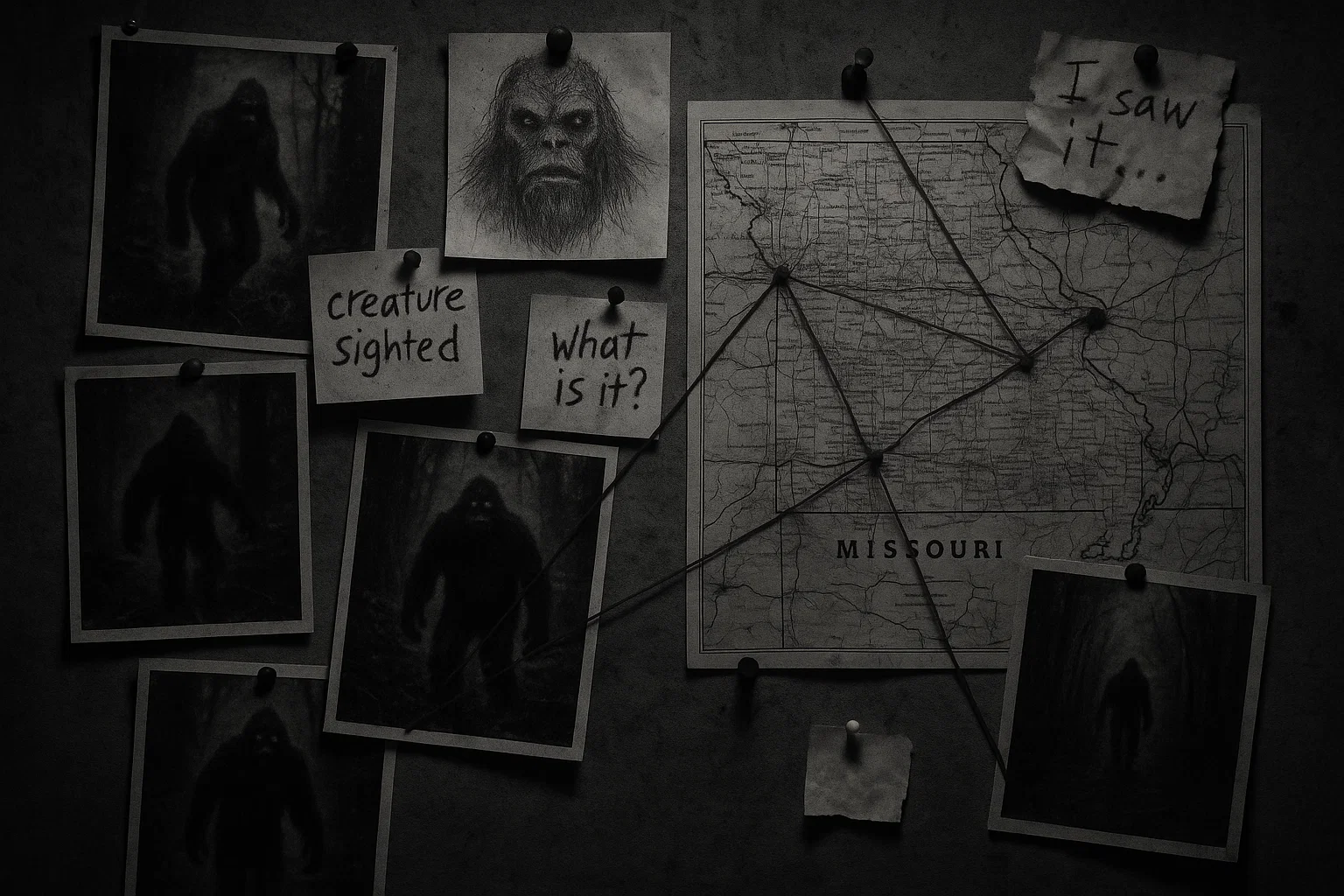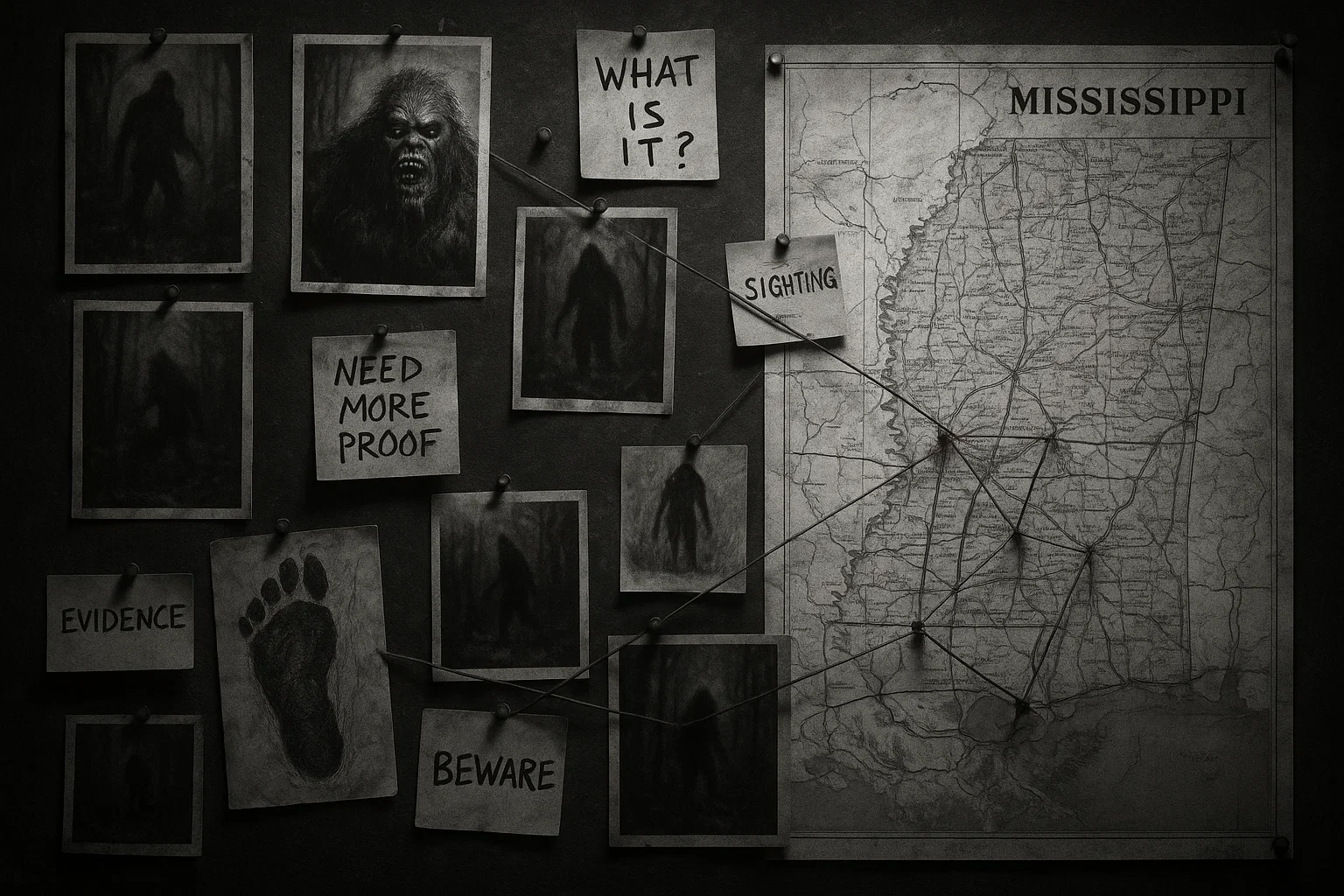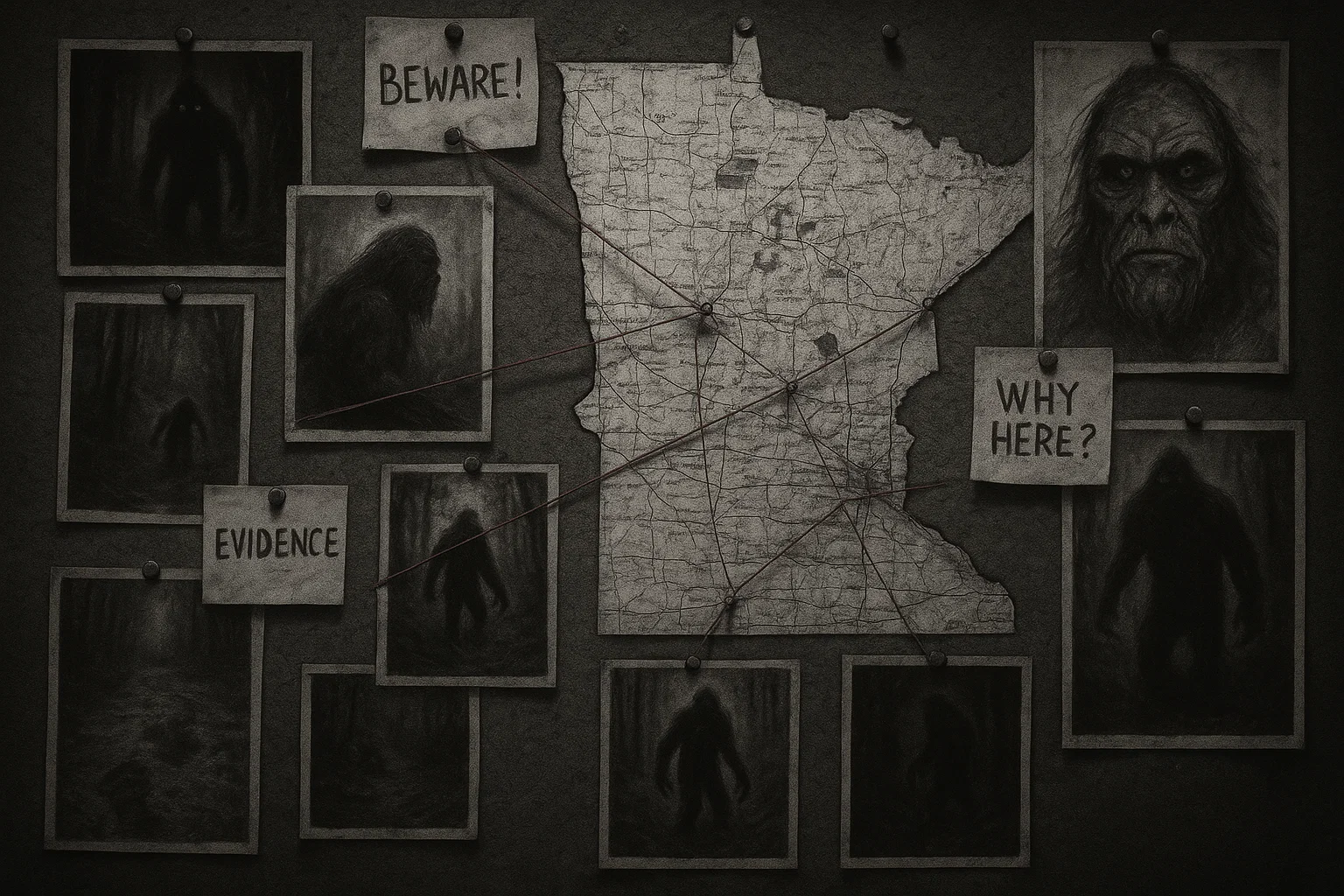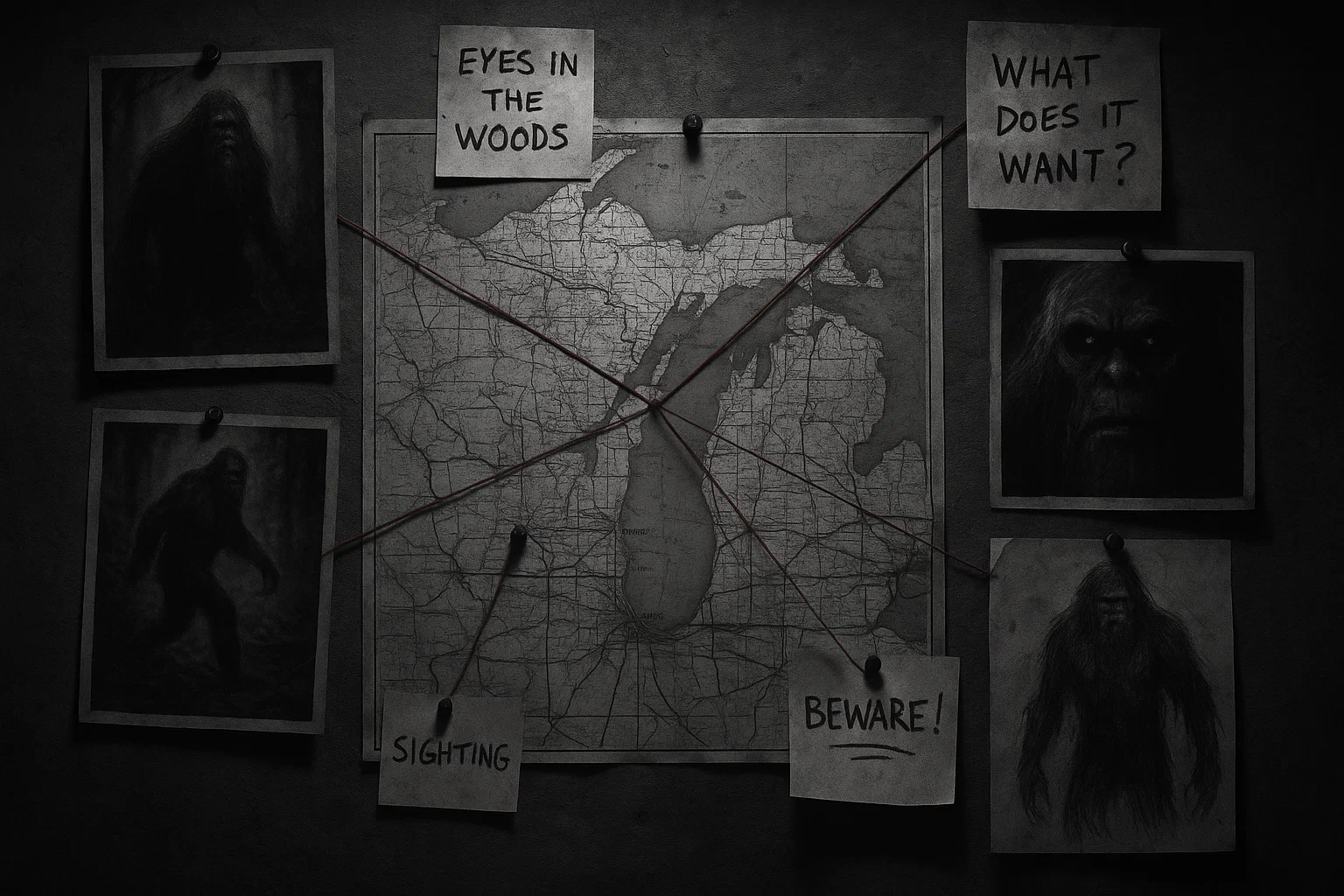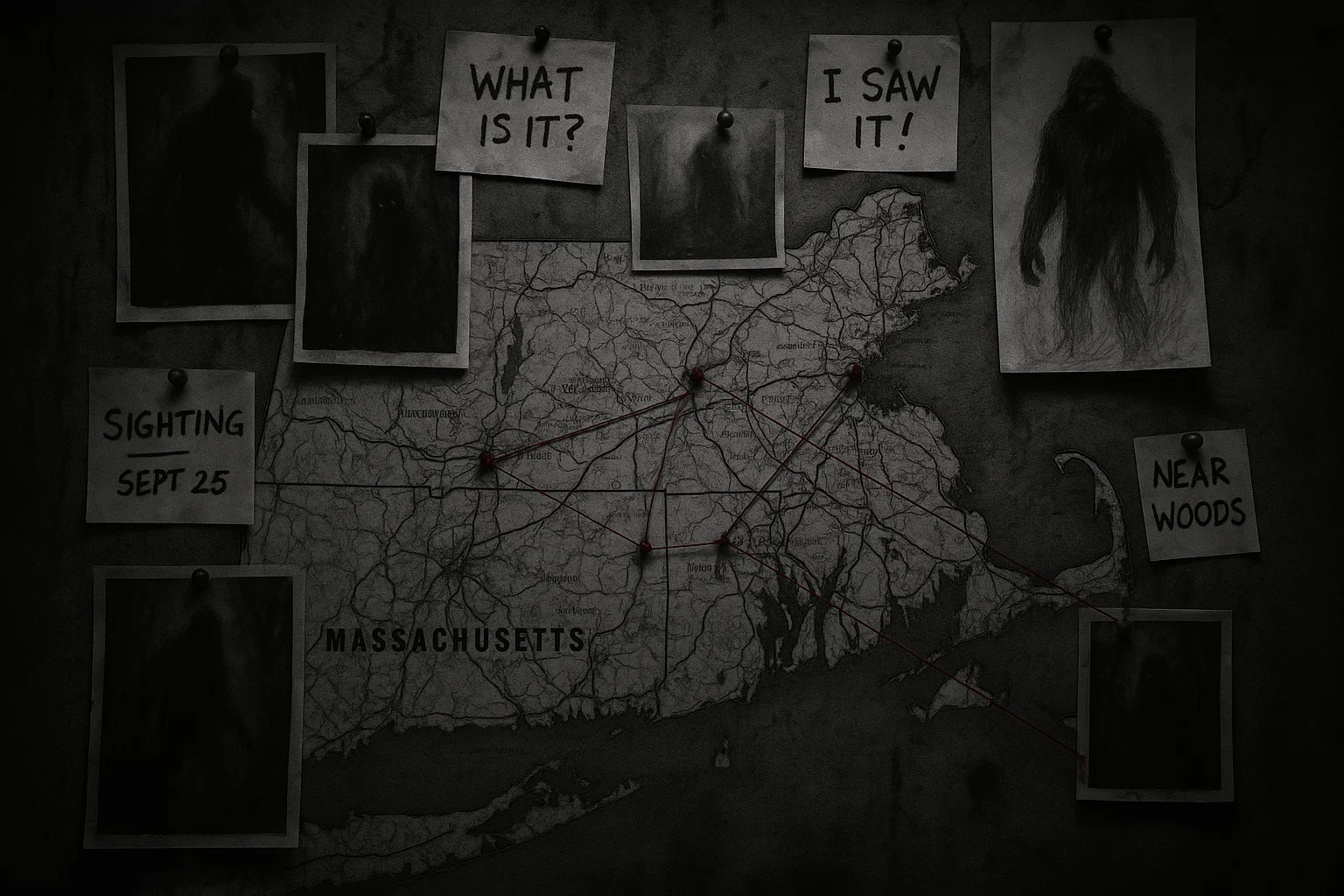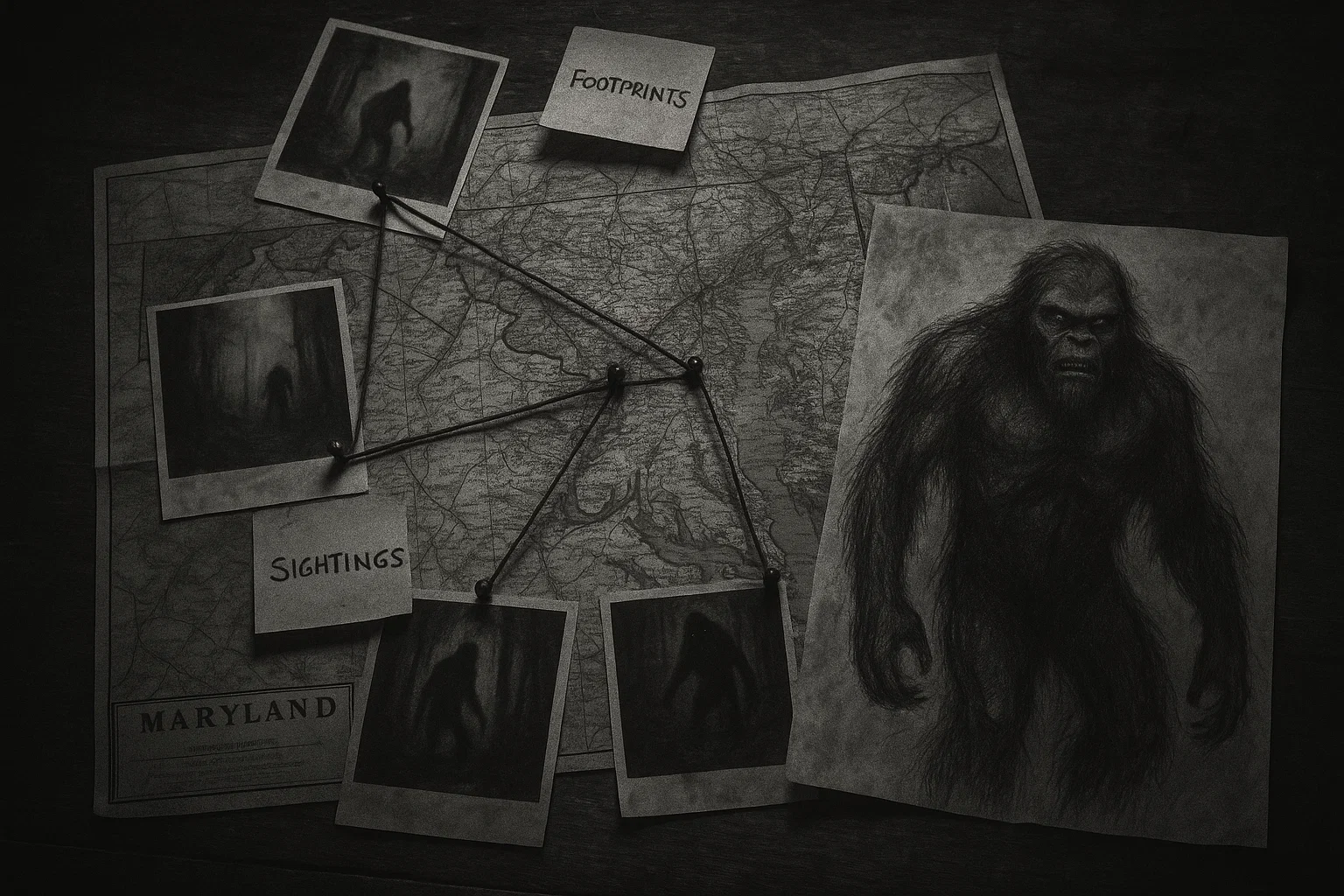Missouri Bigfoot sightings have long fascinated residents and researchers, weaving a tapestry of intrigue across the Show-Me State’s forests, farmlands, and riverbanks. From the legendary Momo the Monster to lesser-known encounters, Bigfoot sightings in Missouri paint a vivid picture of a towering, hairy creature lurking in the shadows.
With over 147 credible reports documented by the Bigfoot Field Researchers Organization (BFRO), Missouri stands as a key hub for Sasquatch activity, sparking curiosity and debate among believers and skeptics alike.
This article explores the history, key incidents, investigations, and cultural significance of these enigmatic encounters, diving deep into the folklore and mystery that define Missouri’s cryptid legacy.
Table of Contents
Missouri Bigfoot Sightings
The state of Missouri has emerged as a significant hotspot for Bigfoot sightings in Missouri, with reports spanning over a century. The Bigfoot Field Researchers Organization (BFRO) has cataloged 147 credible sightings, placing Missouri among the top states for Sasquatch encounters.
These reports describe a bipedal, hirsute creature, often 6 to 11 feet tall, with dark or reddish-brown fur, a pungent odor, and behaviors ranging from elusive to curious. Sightings occur across diverse terrains, from the rugged Ozark Mountains to the fertile plains along the Mississippi River, with counties like Pike, Crawford, and Jackson reporting frequent activity.
Witnesses often recount eerie details: glowing eyes, guttural vocalizations, and massive footprints. The creature, sometimes called Momo (short for Missouri Monster), is frequently described as emitting a stench akin to skunk or decay. While skeptics attribute these encounters to misidentified bears or hoaxes, the consistency of descriptions across decades fuels speculation about an undiscovered primate.
The table below provides a comprehensive list of documented Missouri Bigfoot sightings, drawn from credible BFRO reports and other sources, organized chronologically.
Table of Missouri Bigfoot Sightings:
| Date | Witness | Location | Description |
|---|---|---|---|
| August 1960 | Anonymous | Near Caruthersville, Pemiscot County | Children observed a creature emerging from an abandoned barn, over 7 feet tall, with dark, almost black fur tinged with green. It had an oval, flat face, walked bipedally with a forward lean, and left large footprints. Loud howls were reported in the area. |
| July 11, 1972 | Doris Harrison, Terry Harrison, Wally Harrison | Louisiana, Pike County | The Harrison siblings saw a 7-foot creature with dark hair and a pumpkin-shaped head in their backyard, holding a dead dog. It emitted a foul odor and fled when noticed. Richard Allan Murray later reported a similar creature in headlights near a creek. |
| July 15, 1972 | B. R. | Near Louisiana, Pike County | Witness saw an 11-foot creature with thick, matted reddish-brown hair stepping over a 4-foot barbed wire fence. It emitted a skunk-like smell, screamed loudly, and mimicked the witness’s movements before heading toward a pasture with dogs in pursuit. |
| October 1989 | Anonymous (Group of 8) | Near Glenwild Cemetery, Cass County | A group saw a 6-7 foot creature with light brown to dirty blond fur, long arms, and dark skin on its face at Glenwild Cemetery. Observed 100 feet away, it approached within 50 feet before vanishing. The sighting lasted 10-12 seconds. |
| October 1991 | Anonymous (Bowhunter) | Near Oak Grove, Jackson County | A bowhunter observed a 7-8 foot creature, over 300 pounds, with black, stringy, matted hair and a skunk-like odor. It had wide shoulders, long arms, and walked upright silently, seen 40 yards away over a dike ridge. |
| June 1994 | Anonymous | Near Sullivan, Crawford County | A motorist saw a 7-foot creature with dark brown hair crossing Highway 19 at night. It moved swiftly into the woods, leaving no tracks due to the paved surface. |
| September 1997 | Anonymous | Mark Twain National Forest, Shannon County | Campers heard heavy footsteps and saw a 6.5-foot creature with reddish-brown hair peering from behind a tree. It emitted a low growl and left 16-inch footprints. |
| May 2001 | Anonymous | Near Springfield, Greene County | A hiker reported a 7-foot creature with dark fur watching from a ridge. It made a whooping sound and retreated, leaving broken branches but no clear tracks. |
| October 2004 | Anonymous | Near Poplar Bluff, Butler County | A hunter heard a loud scream and saw an 8-foot creature with black hair moving through dense brush. It left 18-inch footprints and a foul smell lingered. |
| July 2008 | Anonymous | Near St. Joseph, Buchanan County | A farmer saw a 7-foot creature with dark brown fur near a cornfield at dusk. It moved silently and left large, indistinct tracks in soft soil. |
| May 2012 | Cody (last name withheld) | Near Smithville Lake, Clay County | Cody and three friends in a Jeep felt an eerie silence, then heard heavy footsteps. A 7-8 foot creature with dark fur was briefly seen in the brush, moving away quickly. |
| October 2015 | Anonymous | Near Rolla, Phelps County | A driver saw a 7-foot creature with reddish fur crossing a rural road at night. It had glowing eyes and disappeared into the woods. No tracks were found. |
| August 2020 | Anonymous (Former federal worker) | James Reed Memorial Wildlife Area, Jackson County | Witness found a 16×14-inch scat pile and heard three hoot owl-like sounds within 150 feet, a deep “HumphGrrrr” from 20-30 feet, and chimp-like chirps closer than 50 feet. The area had high-pitched howls from grain silos and signs of habitation in a barn hayloft. |
| June 2023 | Anonymous | Near Eminence, Shannon County | A camper reported a 7.5-foot creature with dark brown fur watching their campsite. It made a low moan and left 17-inch footprints with a 5-foot stride. |
| July 2024 | Anonymous | Northern Missouri (exact location withheld) | A man claimed to communicate with a Bigfoot, feeling infrasound that caused physical shuddering. He spoke to it, saying, “We don’t have to be scared of each other,” and felt a possible telepathic response. No visual details were provided. |
Note: The BFRO classifies sightings as Class A (clear sightings with high credibility), Class B (indirect evidence like sounds or tracks), or Class C (less reliable). All listed sightings are Class A or B.
You May Also Like: Complete Guide to Massachusetts Bigfoot Sightings (1765–2025)
Investigation Efforts in Missouri
Investigating Missouri Bigfoot sightings is a dedicated pursuit involving multiple groups and individuals across the state. The Bigfoot Field Researchers Organization (BFRO) leads these efforts, maintaining a rigorous database of sightings since 1995.
BFRO investigators, such as Carter Buschardt, based in Liberty, Missouri, conduct in-depth interviews to assess witness credibility, ruling out misidentifications or hoaxes. Buschardt, who has consulted on Finding Bigfoot, has led over 100 nighttime expeditions, using thermal imagers, audio recorders, and drones to explore areas like the Ozark Mountains and Mark Twain National Forest.
The BFRO’s Missouri Ozarks Expedition (October 30–November 2, 2025), organized by Mary Ann Ziebell, targets high-activity areas, employing night-vision technology and baiting techniques to attract potential Sasquatch.
Beyond the BFRO, the North American Wood Ape Conservancy (NAWAC) has investigated Missouri sightings, focusing on physical evidence like tracks and scat. Their approach emphasizes scientific rigor, with members collecting samples for DNA analysis, though no conclusive results have been published.
The Ozark Mountain Bigfoot Conference, initiated by Ziebell, brings together researchers, witnesses, and enthusiasts to share findings. Local groups, such as the Missouri Monster Hunters, a grassroots collective, organize community-driven searches in counties like Pike and Crawford, using trail cameras and plaster casts to document footprints.
Independent researchers, like cryptozoologist Lyle Blackburn, have also explored Missouri’s cryptid landscape, particularly the Momo phenomenon. Blackburn’s book, Momo: The Strange Case of the Missouri Monster, details his fieldwork, including site visits and witness interviews.
Other efforts include the Missouri Bigfoot Research Group, a small organization that conducts nocturnal stakeouts and collects audio recordings of suspected Sasquatch vocalizations, such as whoops and wood knocks. Despite these efforts, no definitive evidence—such as a body, clear photograph, or verified DNA—has been found, fueling skepticism. However, the persistence of investigators and the volume of credible reports keep the search alive.
You May Also Like: Complete Guide to Michigan Bigfoot Sightings (1962–2025)
Detailed Case Study: Momo the Monster, July 1972
The Momo the Monster sighting of July 11, 1972, in Louisiana, Pike County, remains the most iconic of Bigfoot sightings in Missouri. Doris Harrison, along with her brothers Terry and Wally Harrison, ages 15, 8, and 5, respectively, encountered a creature in their backyard near Marzolf Hill.
Doris, watching from the kitchen window, described a 7-foot-tall, dark-haired creature with a pumpkin-shaped head, no visible neck, and a foul odor, holding what appeared to be a dead dog. “It was standing there, just looking around, with this dog in its arms,” Doris later recounted. “It was hairy all over, and the smell was awful, like something rotting.” The creature fled into the woods when the children screamed, prompting their father, Edgar Harrison, to investigate, though he found only trampled grass.
Days later, on July 15, Richard Allan Murray, a local fire department chief and city council member, reported a similar sighting. Driving along a creek bed at night, Murray’s headlights illuminated a massive, upright creature with dark fur. “It was huge, maybe 8 feet tall, and it just stood there, staring at me,” Murray said. “I froze, and it took off into the brush.”
A 20-person posse, including local law enforcement, searched the area but found no tracks due to dry ground. The Momo incident sparked national media coverage, with newspapers and radio stations amplifying the story. The event inspired local folklore, with some residents claiming ongoing strange noises and sightings in Pike County, cementing Momo’s place as a cultural phenomenon.
Detailed Case Study: Caruthersville Sighting, August 1960
One of the earliest documented Bigfoot sightings in Missouri occurred in August 1960 near Caruthersville, Pemiscot County. Two children, whose identities remain anonymous due to their age at the time, reported seeing a creature emerge from an abandoned barn.
“It was over 7 feet tall, with dark fur that looked almost black but had a greenish tint in the sunlight,” one child described. “Its face was flat, oval-shaped, and it walked like a person, leaning forward a bit.” The children noted large footprints, approximately 16 inches long, in the soft earth near the barn, and heard loud, echoing howls from the surrounding woods.
The sighting occurred in a rural area with dense vegetation, ideal for concealing a large creature. The children’s parents initially dismissed the account as imagination but reported the incident to local authorities after finding the footprints.
No formal investigation followed, but the sighting was later documented by the BFRO when the witnesses, now adults, submitted their story in the 1990s. The detailed description, including the creature’s bipedal gait and the physical evidence of tracks, aligns with later Sasquatch reports, making this a foundational case in Missouri’s cryptid history.
You May Also Like: Complete Guide to Minnesota Bigfoot Sightings (1896–2025)
Detailed Case Study: James Reed Memorial Wildlife Area, August 2020
On August 20, 2020, a former federal government worker, choosing anonymity due to professional concerns, reported a compelling encounter at the James Reed Memorial Wildlife Area in Jackson County. While exploring the area, the witness discovered a large scat pile, measuring 16 x 14 inches and 5 inches high, unlike any known animal’s.
Later, they heard three hoot owl-like sounds with no pauses, coming from within 150 feet. “It wasn’t like any owl I’d ever heard; it was too rhythmic, too deliberate,” the witness stated. On a subsequent visit, they heard a deep “HumphGrrrr” sound, lasting three seconds, from 20-30 feet away, which “vibrated in my chest like a bass speaker.” In early September, chimp-like chirps and screeches were heard closer than 50 feet.
BFRO investigator Carter Buschardt interviewed the witness, deeming them credible due to their detailed observations and lack of embellishment. The witness noted additional signs: high-pitched howls from metal grain silos west of a barn, suggesting acoustic amplification, and evidence of habitation in a barn hayloft, such as disturbed straw and a lingering odor.
Buschardt’s investigation found no alternative explanations, such as bear activity, and the scat’s size and composition remained unidentified. This sighting highlights the ongoing nature of Missouri Bigfoot sightings and the meticulous efforts to document them.
Bigfoot Sightings vs Other Cryptid Sightings in Missouri
Bigfoot sightings in Missouri are not the only cryptid reports captivating the state’s imagination. The Ozark Howler, a bear-like creature with black shaggy fur, glowing red eyes, and horns, is a prominent legend in the Ozark Mountains. A 2022 sighting near an abandoned ghost town in Shannon County described a creature “as big as a bear but with a cat-like scream that echoed for miles.”
Witnesses reported 15-inch tracks and mutilated deer carcasses, though some attribute these to mountain lions. The Piasa Bird, a mythical winged creature from Native American lore, is another Missouri cryptid, with modern sightings near Alton in Madison County, where a dragon-like figure was reportedly seen gliding over the Mississippi River in 2019.
Paranormal phenomena also abound, including UFO sightings in Cape Girardeau (1941, one of the earliest documented U.S. UFO cases) and ghostly apparitions at the Elms Hotel in Excelsior Springs, where guests report disembodied voices.
The Missouri Monster Hunters have noted potential overlaps, suggesting that areas with Bigfoot sightings, like the Ozarks, often report other unexplained activity, possibly due to the region’s remote terrain and dense forests. While no direct evidence links Sasquatch to the Ozark Howler or Piasa Bird, the shared cultural fascination with the unknown suggests environmental or psychological factors may amplify these reports.
You May Also Like: Complete Guide to Mississippi Bigfoot Sightings (1721–2025)
Conclusion
Missouri Bigfoot sightings continue to captivate the Show-Me State, blending folklore, mystery, and scientific curiosity. From the 1960 Caruthersville encounter to the 2020 James Reed Memorial Wildlife Area incident, these reports paint a consistent picture of a large, elusive creature.
The Momo the Monster saga of 1972 remains a cultural touchstone, while ongoing investigations by the BFRO, NAWAC, and local groups like the Missouri Monster Hunters keep the search alive. Despite the absence of definitive proof, the volume and consistency of Bigfoot sightings in Missouri fuel speculation about an undiscovered primate or a deeply rooted cultural phenomenon.
The enduring allure of these encounters lies in their ability to challenge our understanding of the natural world. Whether Sasquatch is a biological reality or a product of imagination, Missouri Bigfoot sightings inspire wonder and debate, inviting residents and researchers to explore the state’s wild places.
As expeditions continue into 2025 and beyond, Missouri’s cryptid legacy remains a vibrant part of its identity, beckoning those who dare to uncover the truth behind the legend.

